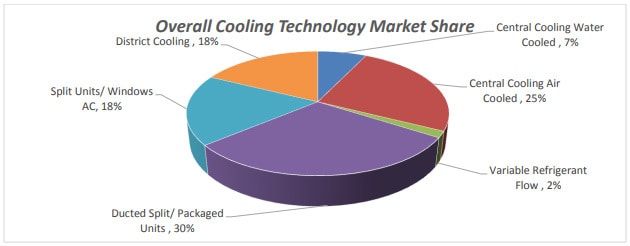Oil rich countries are grappling with dwindling revenue coupled with energy subsidies and higher energy per capital consumption. This situation has prompted the affected nations to develop networks and expand capacity using constrained budgets. Is there a way out of this quagmire? The US and Europe have successfully implemented benchmarking and retrofits for better energy performance. Can Middle East do the same?

Fig 1: A Section of Dubai’s Business Bay
The Situation in Dubai
Dubai is taking the energy efficiency campaign seriously given that cooling is the number one energy consumer in the city with over 80 percent of the buildings’ total energy consumption. For anyone dependent on district cooling systems, the burden on increasing energy bills is becoming too heavy. Questions revolve around the different types of cooling technologies available, how efficient those technologies are, and the size of the market altogether. Benchmarking and real efficiency analysis for this market can show the state of the market and outline the steps to address the challenges.
Market Share of Cooling Market in Dubai
Determining the market share of different cooling technologies within the cooling market of Dubai was part of the tasks of the RSB (Regulatory & Supervisory Bureau)-commissioned study. The other aims were:- Assessment of the “on-site” efficiency of technologies and show the variation of the efficiency with time and
- Establishment of the total cooling load in Dubai
Through a survey of industry experts, the team was able to establish the market share of the cooling market of Dubai. To obtain the overall information regarding the cooling market share, the team also relied on total floor area estimates and data from district cooling sector. Eventually, this is what we have as the view of the cooling market share.

Fig 2: Different Cooling Technologies in Dubai by Market Share
District cooling (now with 18% market share) is expected to dominate the Dubai market in the next few years, with ARANER playing a critical role in its development. Demand for cooling services is growing in tandem with infrastructural growth, with a shift towards district cooling solutions visible. Our district cooling systems are not only sustainable, but also consume up to 50% less energy as compared to conventional systems. You can check the complete analysis here: https://goo.gl/uebYBV
Efficiency of the Market
Efficiency analysis of the Dubai cooling market involved a study of buildings, specifically 145 cooling systems within them. For an assessment of real world performance, the team chose on site testing method. This would allow the assessment to reflect the impact of maintenance practices and age. Further, weather conditions were considered and measurements were done over several months. The results obtained were compared with district cooling system efficiencies. From this real efficiency analysis, it is established that water-cooled solutions provide superior energy efficiency to air cooled solutions, whether at building or district scale. It is worthwhile to note that water-cooled technology is not the best for all situations. For example, it does not cut for intermittent demand or low cooling load density situations. In this regard, it is important to consider the efficiency of air-cooled systems.Improving the Situation
Dubai intends to improve energy efficiency in the coming years, the target being a 30% increase by 2030. Of course, cooling is set to be at the center of these plans, as the Demand Side Strategy (DSM) strategy is looking at a 40% increase in penetration by 2030, up from the current estimate of 20%. This would give the cooling market of Dubai electricity savings of up to 3.4TWh. In line with these massive goals, the program of the cooling market of Dubai comes with several initiatives.- Provision of regulations that promote penetration of district cooling
- Awareness program to support adoption of district cooling- customer groups, developers and district cooling operators to be involved
- The Dubai Municipality to offer desalinated water conservation for DC applications
Challenges in the Implementation
Nevertheless, implementing energy and water efficiency measures in the Dubai is not devoid of challenges. A process this complex needs stakeholder involvement, regulatory effort and appropriate policies. Alongside behavioral change, here are other factors that can help enhance efficiency in Dubai cooling market:
- Education and training of energy professionals
- Data protection and privacy
- Incentive schemes for building retrofits
- Improved access to energy consumption information
Conclusion
Reducing energy and water demand by making facilities in Dubai more efficient is one of the several parts of the Demand Side Management Strategy under the Dubai Supreme Council of Energy. From our experience in the Middle East, regulations will have the most impact on energy efficiency efforts in Dubai. Introducing energy efficiency incentives would also go a long way in encouraging customers to conserve energy. All said, careful analysis is one thing the Dubai cooling market cannot afford to ignore.










